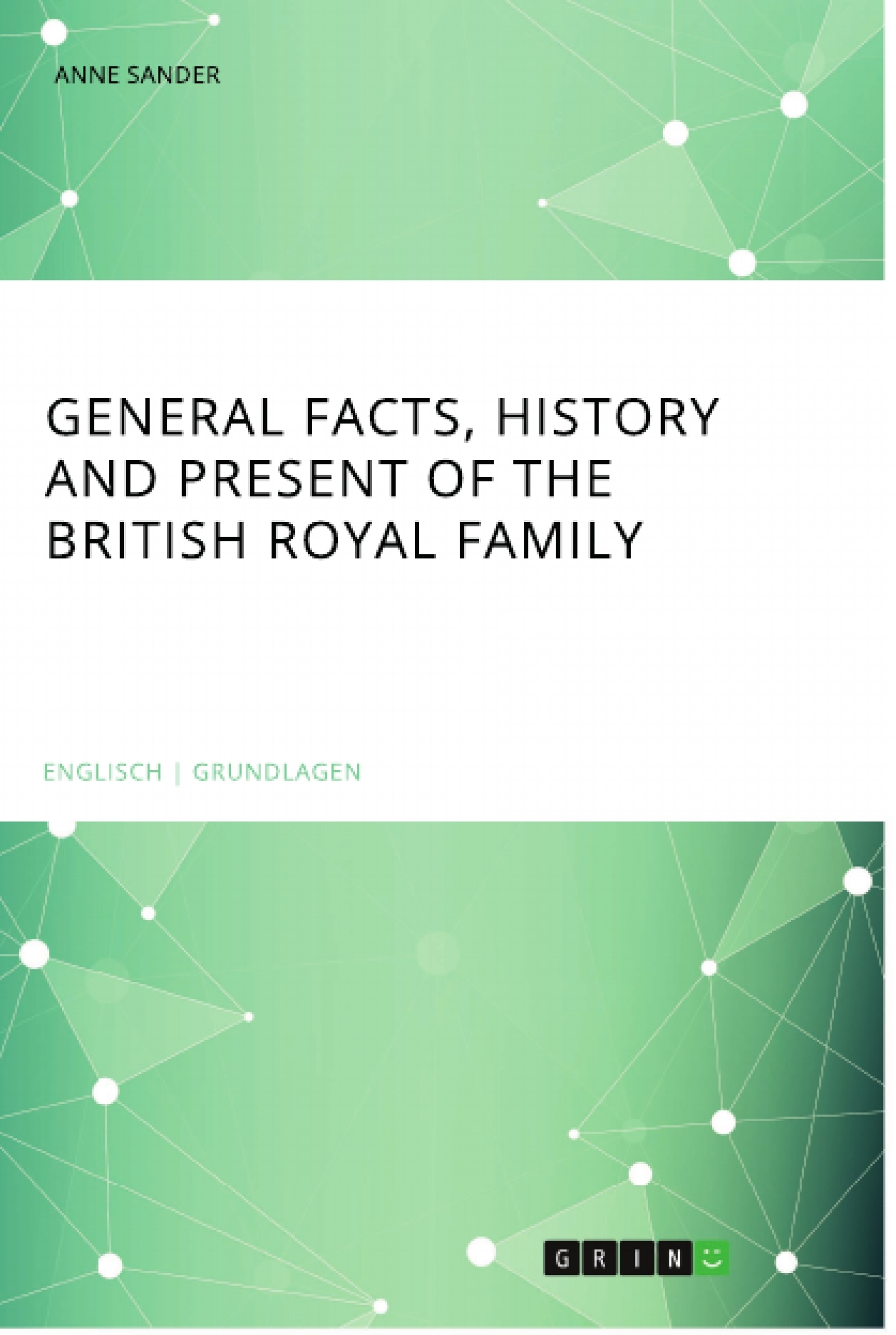The Royal Family has to make sure that there is a strong unity within Great Britain. Every member of the Royal Family is able to participate in every event in the UK, such as openings of new buildings, acts of commemoration or the Olympic Games this summer. Today the head of the Royal Family nearly has no political power, but has more of a representative role. Furthermore the Queen is the Head of the Armed Forces. With that function she is the only one who can decide whether the country is at war or when the war is finished. Every British Monarch is Head of the Church of England which comprises the appointment of bishops. Every priest has to swear an oath not on the Pope like the Catholics or on God like Protestant priests, but on the Queen herself.
Table of Contents
- 1. General Facts
- Role
- Coronation
- The Royal Coat of Arms and motto
- 2. History
- Offa
- King William I
- King Henry VIII
- 3. Present
- Queen Elizabeth II
- Royal Children
- Royal Grandchildren
- The Royal Wedding
Objectives and Key Themes
The objective of this text is to provide a concise overview of the British Royal Family, covering its historical development, current role, and key figures. The text aims to be informative and accessible, offering a brief insight into significant aspects of the monarchy.
- The evolving role of the British monarchy
- Key historical figures and their impact on the institution
- The traditions and ceremonies surrounding the monarchy
- The symbolism and significance of the Royal Coat of Arms
- The personal lives of significant monarchs and their impact on history
Chapter Summaries
1. General Facts: This chapter introduces the fundamental aspects of the British Royal Family. It details the family's role in maintaining national unity, their participation in various UK events, and their primarily representative function in modern politics. The chapter also highlights the monarch's position as Head of the Armed Forces, with the sole authority to declare war and peace, and their role as Head of the Church of England, encompassing the appointment of bishops. The description of the Coronation ceremony provides a vivid image of the ritual's grandeur, including its historical aspects and the significance of the coronation regalia. The chapter concludes by describing the Royal Coat of Arms, emphasizing its symbolism and historical context.
2. History: This section delves into pivotal moments and figures in the Royal Family's history. It begins with King Offa, the first Anglo-Saxon to claim the title of King of England, establishing a foundation for the monarchy. The reign of William the Conqueror is discussed, emphasizing his significant achievements, such as the construction of the Tower of London and Winchester Cathedral. The chapter culminates in a detailed examination of the reign of King Henry VIII, renowned for his six marriages. This section meticulously explores Henry VIII’s personal life, particularly his marital issues that led to significant religious and political changes, including his break from Rome and the establishment of the Church of England. The narrative underscores the complex interplay between personal decisions, political maneuvering, and lasting historical consequences.
Keywords
British Monarchy, Royal Family, Coronation, King Henry VIII, William the Conqueror, Church of England, Royal Coat of Arms, British History, Head of State, National Unity, Tradition, Ceremony.
British Royal Family: A Comprehensive Overview - Frequently Asked Questions
What topics are covered in this text?
This text provides a comprehensive overview of the British Royal Family, encompassing its historical development, current role, key figures, traditions, and ceremonies. It includes general facts about the monarchy, significant historical events and monarchs, and a focus on the symbolism and significance of the Royal Coat of Arms. The text also examines the evolving role of the monarchy and the personal lives of key monarchs and their impact on history.
What is the objective of this text?
The objective is to offer a concise and accessible overview of the British Royal Family, providing informative insights into significant aspects of the monarchy.
What are the key themes explored?
Key themes include the evolving role of the British monarchy, key historical figures and their impact, traditions and ceremonies surrounding the monarchy, the symbolism of the Royal Coat of Arms, and the personal lives of significant monarchs and their impact on history.
Which historical figures are discussed?
The text discusses King Offa, William the Conqueror, and King Henry VIII, highlighting their contributions and impact on the British monarchy and history.
What is covered in the "General Facts" chapter?
This chapter details the Royal Family's role, the Coronation ceremony, the Royal Coat of Arms and its symbolism, and the monarch's position as Head of the Armed Forces and Head of the Church of England.
What is covered in the "History" chapter?
This chapter delves into the reigns of King Offa, William the Conqueror, and King Henry VIII, focusing on their significant achievements, personal lives, and the lasting consequences of their decisions. It emphasizes the complex interplay between personal decisions, political maneuvering, and historical consequences.
What are the key words associated with this text?
Key words include: British Monarchy, Royal Family, Coronation, King Henry VIII, William the Conqueror, Church of England, Royal Coat of Arms, British History, Head of State, National Unity, Tradition, Ceremony.
What type of information is this text intended for?
This text is intended for academic use, facilitating the analysis of themes related to the British Royal Family in a structured and professional manner.
Where can I find a Table of Contents?
The text includes a detailed table of contents outlining the chapters and sub-sections.
What is the purpose of the chapter summaries?
The chapter summaries provide concise overviews of the key information and arguments presented in each chapter.
- Quote paper
- Anne Sander (Author), 2013, General Facts, History and Present of the British Royal Family, Munich, GRIN Verlag, https://www.hausarbeiten.de/document/416288



